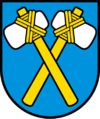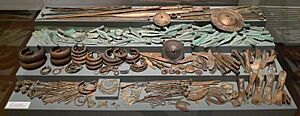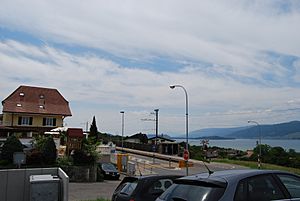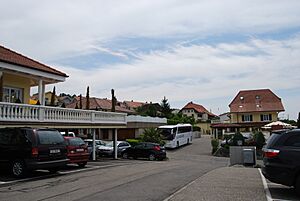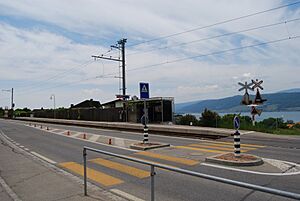Mörigen facts for kids
Quick facts for kids
Mörigen
|
||
|---|---|---|
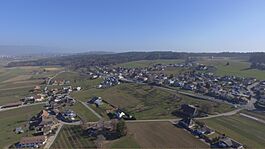 |
||
|
||
| Country | Switzerland | |
| Canton | Bern | |
| District | Biel/Bienne | |
| Area | ||
| • Total | 2.16 km2 (0.83 sq mi) | |
| Elevation | 480 m (1,570 ft) | |
| Population
(Dec 2020 )
|
||
| • Total | 875 | |
| • Density | 405.1/km2 (1,049.2/sq mi) | |
| Postal code |
2572
|
|
| Surrounded by | Epsach, Hermrigen, Sutz-Lattrigen, Täuffelen, Twann | |
Mörigen is a small town, also called a municipality, in Switzerland. It's located in the canton of Bern, right by the beautiful Lake Biel. Mörigen is known for its long history, especially its ancient settlements from the Stone Age and Bronze Age. Today, many people who live here travel to nearby cities for work.
Contents
History of Mörigen
Mörigen was first mentioned in old records in the year 1196. Back then, it was called Moringen.
Ancient Settlements and Discoveries
Thousands of years ago, Mörigen was home to very old settlements. During the Bronze Age, around 900 BC, a large village stood on the lake shore. People lived in stilt houses, which were homes built on poles over the water. This settlement was part of the Urnfield culture, a group of people known for burying ashes in urns.
The site was discovered in 1843. Later, when the water level of Lake Biel dropped, the entire ancient village became visible. Many old items were found, first by people collecting them as hobbies. Later, these finds helped start important museums in Switzerland, like the Schwab Museum in Biel and the Swiss National Museum.
In 1873, the government of Bern took over the excavations. They found an oval-shaped settlement, about 190 by 120 meters in size. They also found parts of buildings and bridges. Items like willow baskets, straw, and grains showed how people lived and what they ate.
Today, about 1,400 bronze objects from Mörigen are in Swiss museums. These include swords, tools, jewelry, and horse gear. Some items even had pieces of iron, showing early iron use in Switzerland. Pottery and glass beads were also found.
Besides the well-known Bronze Age village, there were even older settlements. These date back to the Neolithic period (Stone Age), from the 4th to 3rd millennium BC. There were also early Bronze Age sites.
During the Roman era, a small settlement existed nearby. Graves from the Early Middle Ages were also found near the lake.
From Medieval Times to Today
In the Middle Ages, Mörigen was part of a territory called Herrschaft of Nidau. It was likely managed by a local family named Mörigen. They might have had castles to control the area. In 1398, Bern took control of this region, including Mörigen.
A small chapel was built in Ober-Mörigen. By 1497, a priest from Täuffelen looked after it. When Mörigen became Protestant in 1528, it joined the Täuffelen church area.
For a long time, people in Mörigen mainly grew grain, tended vineyards, and fished. In 1916, a railway connected the village to other parts of the country. The town's population grew a lot in the 1960s after a new road to Biel was built. Today, Mörigen is a commuter town. This means many people live there but travel to jobs in bigger cities like Bern and Biel.
Geography of Mörigen
Mörigen covers an area of about 2.2 square kilometers (0.85 square miles). A large part of the land, about 59%, is used for farming. Forests cover about 17% of the area. Buildings and roads make up about 21% of the land.
The municipality is located on the right bank of Lake Biel. This beautiful lake is a key feature of the area.
In 2010, Mörigen became part of a new administrative district called Verwaltungskreis Biel/Bienne. This change helped organize local government better.
Mörigen's Coat of Arms
The blazon of Mörigen's municipal coat of arms shows two silver stone axes on a blue background. The axes have golden handles. This design represents the town's ancient history and the important stone tools found there.
Population and People
Mörigen has a population of about 886 people (as of December 2011). Over the last ten years, the population has grown slightly. Most people in Mörigen speak German as their first language. French is the second most common language spoken.
In 2008, about 49% of the population was male and 51% was female. About 20% of the people living in Mörigen were born there. Many others were born in the same canton (Bern) or elsewhere in Switzerland.
Young people, aged 0 to 19, make up about 20% of the population. Adults, aged 20 to 64, are about 56%. Seniors, over 64 years old, make up about 24% of the population.
Most adults in Mörigen are married. There are also single, divorced, and widowed individuals. In 2010, there were 83 households with just one person. There were also 22 households with five or more people.
The chart below shows how Mörigen's population has changed over time:

Transportation in Mörigen
Mörigen has its own train station, which is part of the Aare Seeland mobil network. This makes it easy for people to travel to and from the town.
Economy and Jobs
In Mörigen, people work in different types of jobs. Some work in the primary sector, which includes farming. Others work in the secondary sector, like manufacturing or construction. Many also work in the tertiary sector, which includes services like sales, hotels, restaurants, and education.
In 2008, there were 119 people working in Mörigen. Most of the jobs were in the service sector. Many people who live in Mörigen travel to other towns for work. About 67% of workers use a private car to get to their jobs.
Religion in Mörigen
Based on a 2000 survey, most people in Mörigen belong to the Swiss Reformed Church, which is a Protestant church. A smaller number are Roman Catholic. There are also a few people who belong to Orthodox Christian churches or other Christian groups. Some people do not belong to any church.
Education in Mörigen
In Switzerland, education starts with one year of non-mandatory Kindergarten. After that, children attend six years of Primary school. Then, they go to three years of lower Secondary school. After secondary school, students can choose to continue their education at a university or start an apprenticeship.
In Mörigen, the primary school works together with the nearby town of Sutz-Lattrigen. Children attend kindergarten and primary school in either Mörigen or Sutz-Lattrigen. For grades 7 to 9, students go to the Oberstufenzentrum Täuffelen. For higher education, the high school is located in Biel-Bienne.
See also
 In Spanish: Mörigen para niños
In Spanish: Mörigen para niños


